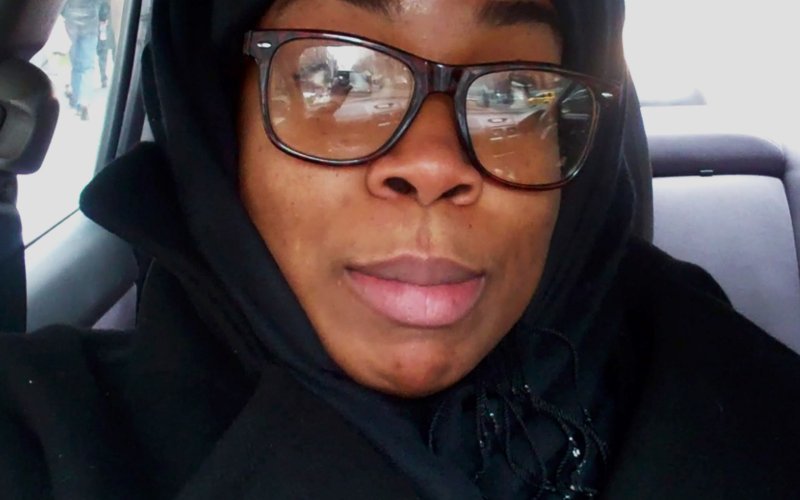By Felice Leo’n
When I heard of World Hijab Day on Feb. 1, there was no question in my mind that I would participate. At a time when there is a pervasive anti-Islamic sentiment in the United States and beyond, I wanted to stand in solidarity with Islamic women.

People fear that which they don’t understand. I’ve visited Islamic countries and have been mistaken for a prostitute on several occasions (once twice in the same day), or a nanny. No hard feelings. I realize that was a negative perception of the hijab-less Black woman in the Middle East that caused these experiences. Rather than perpetuating unfair stereotypes of my own, I would live a day as a hijabi. This was my opportunity to stop speculating on what it was like to wear the veil and to walk the walk. I would wander through New York City neighborhoods: Midtown, Chinatown, Little Italy, SoHo, Harlem, Queens and Long Island.
Initially, I didn’t know what to expect and that made me a bit uneasy. That morning I had a conversation with my mother about my decision. “Are you really going to wear that”? my mother asked. There was a sense of disbelief in her voice. An old-school southern woman, she had preconceived notions of women wearing the veil and even admitted to having some hostility towards me for wearing one, given her understanding of what the hijab represented. She thought the hijabs to be oppressive and said that wearing one “dimmed” my light. She mentioned that some Westerners associate terrorism with Islam. My response: “That’s some B-S.” Many Muslim women cover themselves in veils as a part of their faith. A weathered black scarf served as my hijab, which covers the hair, neck, and ears, whereas the more conservative niqab and Afghan-style burqa are longer veils—one covers the face, leaving a slit for the eyes while the other is full-length leaving only a mesh in front of the eyes and secured by a cap of sorts.
After Mom’s reaction, I was ready for the worst. Islamophobia is real. I often witness this phobia and angst towards Muslims living in the West: in the airports, on television and in random conversations. I’ve experienced a fair share of discrimination and harassment as a Black woman living in the U.S, so I anticipated that a Black hijabi would also be a target for bigotry.
My first stop was a non-denominational meditation center in Midtown Manhattan. I attend the center regularly. This past Sunday, I assisted with Sunday School, which means that I helped the children sign the attendance book and assisted the teacher with small crafts and activities. Given that I was working with a very astute group of 4- to 7-year-olds I expected a slew of questions about by headpiece. In my 75 minutes of class time, no one mentioned a thing. The children were more concerned with cutting and coloring their paper puppets than poking and prodding into why I was wearing a hijab. I was ready to respond to the children, but I was more so relieved that they spared me the ‘Twenty Questions’.
After Sunday School, I went to Chinatown. I wanted to continue to interact with people, so I decided to spend my time doing a combination of walking and asking for directions. “Hi, where’s the nearest subway,” I asked. People, for the most part, obliged. During one encounter, I entered a store and asked for directions. “Two blocks,” a man said while gesturing. The response was terse. Perhaps there was a language barrier; a young woman in the store interjected, asking tons of follow-up questions about my destination and the preferred train line. She wanted me to find my way.
Within a few blocks, I found myself in Little Italy. As I attempt to get my bearings, a man approached offering a hand. Apparently, I looked lost. I was startled and declined his offer.
The streets of Little Italy and SoHo converged. I took a break on a brass bench outside of McNally Jackson Books. I sat meditatively, to regroup and mentally prepare for the rest of the trip. By that point I had been walking for a few hours, and my nerves began to calm. I realized that the hijab wasn’t isolating and my initial trepidation was ill-founded. While being veiled, I understood that I did not exist autonomously—I was a part of a greater, accepting whole. Two hipster women walked into the bookstore’s café. One offered a compliment, “I like your spectacles,” she said. I smiled and thanked her. The kindness continued—before hopping on the train to Harlem I caught the eye of two older women (on different occasions) that offered smiles.
Read more: I Wore a Hijab for a Day. Here’s What Happened
Source: The Daily Beast


Leave a Reply